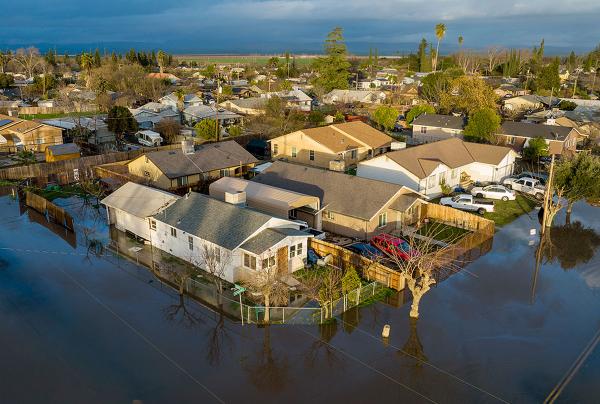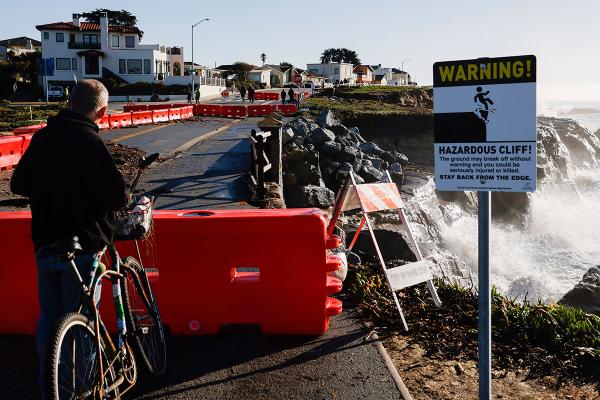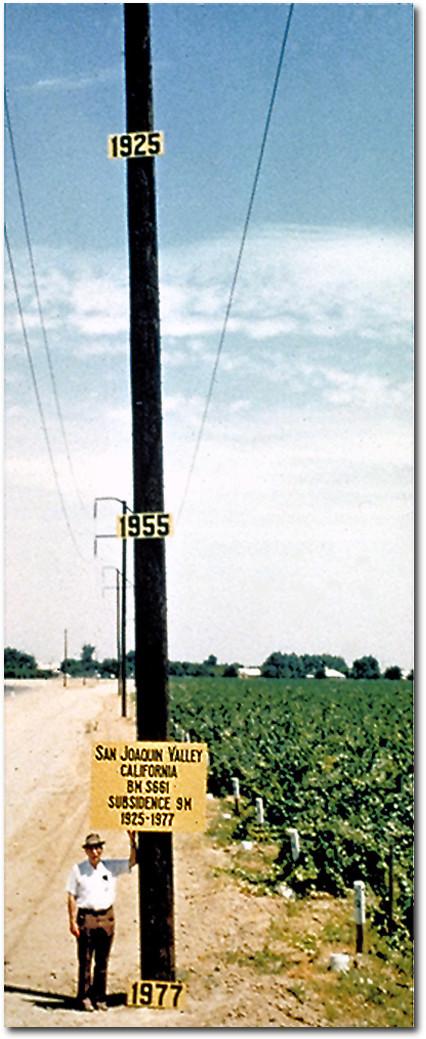
Following weeks of storms, floodwaters cover streets in area of Merced County, California, on January 10, 2023. Photo: AP
Beginning after Christmas, California was hard hit by extreme rain. A series of “atmospheric rivers”—plumes of air full of water vapor coming across the Pacific Ocean—pummeled the state with rain on the coast and snow in the Sierra Nevada mountains. This rain follows three years of one of the most intense droughts in California history. The droughts dried out forests, fueling wildfires; lowered water levels in rivers that can’t support fish; and cut water to farms. And now, this sudden burst of rainstorm after rainstorm has brought some relief from the drought, but also a lot of suffering.
California is caught in what scientists call “weather whiplash”—jumping from drought to floods, and back again.
This “whiplash” is now intensifying because of climate change—the continuing rise of the temperature of the air and water on the planet. Climate change is driven by the capitalist-imperialist system which rules the planet. This is a system whose development and profitability have relied on burning immense amounts of oil, coal and gas—injecting carbon dioxide and methane that trap heat in the atmosphere and change the climate of the planet.
Human and Social Cost of the Extreme Rainstorms

Due to California storms, man sleeps in his car at the parking lot of an evacuation center in Santa Barbara, January 9, 2023. Photo: AP
The pounding of California by the rainstorms has done a lot of damage—at least 20 people have been killed. Homeless people, many living in tents in areas particularly vulnerable to rushing water, have been savagely hit by floods, some killed. Farmworkers, who live on the bitter edge of needing to work today to eat tomorrow, have seen fields and homes flooded and are left with no place to live and no place to work. The onslaught of rain has loosened the soil on hillsides, and mudslides have wiped out homes, cars, roads and bridges.

Barricades block off a crumbling section of West Cliff Drive in Santa Cruz, California, January 17, 2023. Storms slammed the region causing erosion, flooding and major damage to homes and roads. Photo: AP
While, at least for now, the storms have stopped, the soil is so saturated that dangerous mudslides can continue for weeks or even months. Homes and buildings have been engulfed by water or mud, and even completely destroyed. Lives will continue to be ripped apart.
Some Scientific Background: Weather Patterns are Radically Changing
“Normal” weather for much of California for thousands of years was long periods of no rain in summer and fall, followed by what can be intense rain in the winter. But we are already far beyond “normal.” A report published in Nature Climate Change last year found that the years between 2000 and 2021 might be the Southwest’s driest 22-year period in 1,200 years. This kind of extended drought dries out forests, makes it harder and harder for farms to grow crops, and drains the reservoirs which carry drinking water for the cities. But even in this intense drought, the long dry period has been repeatedly punctuated by storms—2017 was one of the wettest years on record.
Usually, roughly half of California’s rain and snow comes through “atmospheric rivers”—the equivalent of rivers in the sky transporting massive amounts of water vapor. These don’t necessarily cause floods or mudslides, but in the recent storms, many atmospheric rivers came one after the other. The result was that the land could not dry out before the next storm hit, and this led to massive floods. And there was record snow in the Sierra Nevada mountains. All this snow, which melts in the spring and summer, plays a really important role in easing the long drought.
But even all this record rain and snow, at least so far, is not enough to make up for the many years of drought. And, looking to the future, scientists project that as the climate of the whole planet gets hotter, what will happen in California will be more intense “whiplash”—both extended and more intense drought, and wetter and more intense storms. A major, long-term effect will be the increasing lack of water for its cities and for agriculture, even as it is hit by savage storms.
Some Historical Background: Unsustainable and Exploitative Capitalist-Imperialist Development
After the U.S. stole California from Mexico in 1848, it developed a system of capitalist agriculture which now supplies a big part of the fruits and vegetables in this country. These crops are largely grown in the vast Central Valley. Before this region was transformed into the main agricultural area in California, it essentially dried out every summer and fall, with very little rain. But as it was turned into an area defined by very large farms—many of them major capitalist enterprises—that were growing fruit and vegetables for a national capitalist market, there were harmful long-term consequences:
- The profitability of this large-scale capitalist agriculture, which is driven to expand production and cheapen costs, called forth the massive and reckless use of pesticides. This had all kinds of negative environmental and social health effects.
- This system of agriculture has historically depended on, and continues to depend on, huge armies of extremely exploited labor from Mexico.
- This system of agriculture has required, and continues to require, huge amounts of water to irrigate crops—with the water often coming from hundreds of miles away.
The effect of all this on the people, and the environment, and whether it could be sustained in the long run—this was not and is not a factor in the calculations of the corporations which have owned most of the farms, and which are driven to compete for short-term profits, or face the threat of going under.1
As mentioned, California's agriculture makes huge demands on water. Eighty percent of the water in California goes to agriculture—and even in relatively wet years, there is almost never enough. One way the problem has been temporarily eased is to drain the aquifers—these are massive pools of underground water that have formed from rainwater seeping down over many years. In some places so much has been drained from the aquifers that the ground level has dropped over 30 feet! (This has been going on for many decades—see the accompanying picture from the 1970s dramatically illustrating this.) When there is a year with a lot of rain, the aquifers can be partially replenished. But in years of intense drought, the aquifers get further drained.

Signs on the pole in this old picture shows dramatically how much the surface of the land has dropped in California’s Central Valley from 1925 to 1977. The surface of the land fell because water was pumped out of underground aquifers to use to grow crops. Photo: USGS.gov
And agriculture is only one part of the whole, unsustainable, environmentally destructive capitalist system. Cities and population centers have developed in unsustainable ways. Just looking at California, and its water crisis, the massive urban areas and suburbs of California exist on water shipped from all over—the Colorado River, which is not even in California, provides half the water for Los Angeles. As cited in a recent New York Times opinion piece, Marc Reisner's 1986 book Cadillac Desert reported that “Everything depends on the manipulation of water—on capturing it behind dams, storing it, and rerouting it in concrete rivers over distances of hundreds of miles. Were it not for a century and a half of messianic effort toward that end, the West as we know it would not exist.”
Stepping Back and the Revolution for a Sustainable Future
For many decades, California agriculture and urban development have been on a course that CANNOT be sustained in the long run. The long run is here.
What we are now confronting is climate change leading to the “weather whiplash” of extreme rainstorms and droughts... interacting with irrational and unsustainable capitalist-imperialist economic and social development.
Here at revcom.us, we address issues of the larger environmental crisis and the revolutionary way out. The point is, there is a viable and liberatory alternative! Readers are encouraged to look at the Constitution for the New Socialist Republic in North America and the companion document Some Key Principles of Socialist Sustainable Development.
